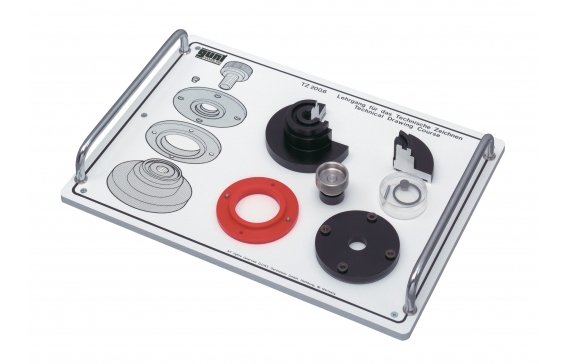TZ 200.61 Engineering drawing: rotationally symmetrical components

Reading and understanding complex engineering drawings are core skills. They are at least equivalent to drawing ability itself, and are the aim of this GUNT course. The use of concrete applications and real-world workpieces and standard parts is intended to develop engineering communication skills. The actual drawing tasks are developed from a larger technological environment.
TZ 200.61 provides an introduction to the graphical representation of rotationally symmetrical components and the representation of sections. The central element is a drilling jig that can be used, in this case, to drill into a bearing cap. A quarter has been cut out of the base of the drilling jig. This illustrates the concepts of “section” and “half-section”.
The cut-out quarter is also provided on the base plate, so that the difficult topic of sectional views can be demonstrated clearly.
All parts are clearly arranged on a base plate. An exploded view, attached to the base plate, illustrates the overall arrangement.
The manufactured parts are precision-manufactured and therefore are also suitable for measuring exercises.
Ideally, the parts should be used in the classroom as an exercise. Two or three students can work meaningfully with one kit.
- GUNT course: engineering drawing
- consists of drilling jig and workpiece
- introduction to sectional views
- part of the GUNT course on engineering drawing
- rotationally symmetrical components using the example of a practical drilling jig for machining of a workpiece (bearing cap)
- base of the drilling jig prepared as a half section
- all individual parts of the drilling jig precision-manufactured from aluminium
- PVC bearing cap as workpiece
- base plate with printed exploded drawing
- storage system for parts
- accompanying instructional material considers practical and interdisciplinary forms of teaching
- introduction to graphical representation of rotationally symmetrical components
- familiarisation with sectional views: full section and half section
- dimensioning of rotating parts and threads
- production engineering aspects
- devices as aids for drilling and reaming
- complete machining on modern tooling machines
- tolerances, fits, surface specifications
- classification of the workpiece (bearing cap) in a larger technological context
